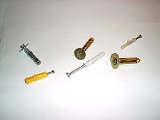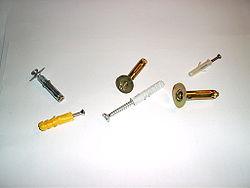
Wall plug
Encyclopedia

Fastener
A fastener is a hardware device that mechanically joins or affixes two or more objects together.Fasteners can also be used to close a container such as a bag, a box, or an envelope; or they may involve keeping together the sides of an opening of flexible material, attaching a lid to a container,...
used in building
Building
In architecture, construction, engineering, real estate development and technology the word building may refer to one of the following:...
s. It allows screw
Screw
A screw, or bolt, is a type of fastener characterized by a helical ridge, known as an external thread or just thread, wrapped around a cylinder. Some screw threads are designed to mate with a complementary thread, known as an internal thread, often in the form of a nut or an object that has the...
s to be fitted into masonry
Masonry
Masonry is the building of structures from individual units laid in and bound together by mortar; the term masonry can also refer to the units themselves. The common materials of masonry construction are brick, stone, marble, granite, travertine, limestone; concrete block, glass block, stucco, and...
walls.
There are many forms of wall plug, but the most common principle is to use a tapered tube of soft material, such as plastic. This is inserted loosely into a drilled hole, then a screw is tightened into the centre. The screwing action wedges the plug firmly in place, the soft material conforming tightly to the masonry.
History
Before commercial wall plugs, fixings were made to brick or masonry walls by chiselling a groove into a soft mortar joint, hammering in a crude wooden plug and then attaching to the wooden plug. This was time consuming and required a large hole, thus more patching of the wall afterwards. It also limited the holes' location to the mortar joints.The original wall plug was invented by John Joseph Rawlings
John Joseph Rawlings
John Joseph Rawlings was a British engineer and inventor of the wall plug, also known from his name as the rawlplug. He invented it in around 1910-1911, filed a patent in 1911, trademarked the rawlplug name in 1912 and was granted the patent in 1913...
in 1911, and marketed under the name Rawlplug. These plugs became popular after the First World War, when a demand for retro-fitting existing buildings with new electric lighting coincided with a shortage of labour, encouraging many new labour-saving innovations in the building trade. Rawlplug gained their prominence from their adoption in the British Museum
British Museum
The British Museum is a museum of human history and culture in London. Its collections, which number more than seven million objects, are amongst the largest and most comprehensive in the world and originate from all continents, illustrating and documenting the story of human culture from its...
.
Early wall plugs were thick-walled fibre tubes, made of parallel strings bonded with glue. Most current brands are plastic
Plastic
A plastic material is any of a wide range of synthetic or semi-synthetic organic solids used in the manufacture of industrial products. Plastics are typically polymers of high molecular mass, and may contain other substances to improve performance and/or reduce production costs...
, first designed in 1958 by Artur Fischer, known as the Fischer Wall Plug.
Some early plugs, including Rawlings', were also made of soft metal strips, punched with raised perforations for grip.
Fibre and resin mixes
On crumbling walls it may be difficult to drill a clean hole, or the force of the expanding plug may be enough to cause cracking. In these cases a hardening liquid or putty mixture may be used instead.One of the first of these mixtures was produced by Rawlplug and was composed of dry white asbestos fibres, sold loose in a tin. The user wetted some into a ball (usually by spitting on them) and pushed this plug of putty into the hole. A small tamper and spike was supplied with the kit. This putty worked very well, but the hazard of the asbestos fibres
Asbestos fibers
Asbestos fibers are released from asbestos containing materials . Friable asbestos containing materials release fibers more readily than encapsulated asbestos containing materials.- Determining airborne asbestos fiber levels :...
means that the product is no longer available.
However, another way to fix wall plugs is accomplished by the application of a cotton weaved pad which has been impregnated with a special formulated gypsum
Gypsum
Gypsum is a very soft sulfate mineral composed of calcium sulfate dihydrate, with the chemical formula CaSO4·2H2O. It is found in alabaster, a decorative stone used in Ancient Egypt. It is the second softest mineral on the Mohs Hardness Scale...
to bond into the wall. The pad is wetted, wraped around the wall plug, and the two are inserted into the hole, after a short time it hardens and a strong bond is achieved and the wall fitting can be applied. It is used in combination with wall plugs in masonry
Masonry
Masonry is the building of structures from individual units laid in and bound together by mortar; the term masonry can also refer to the units themselves. The common materials of masonry construction are brick, stone, marble, granite, travertine, limestone; concrete block, glass block, stucco, and...
, ceramic
Ceramic
A ceramic is an inorganic, nonmetallic solid prepared by the action of heat and subsequent cooling. Ceramic materials may have a crystalline or partly crystalline structure, or may be amorphous...
, wood and plasterboard walls.
Modern resin mixtures are based on polyester resin
Polyester resin
Polyester resins are unsaturated resins formed by the reaction of dibasic organic acids and polyhydric alcohols. Polyester resins are used in sheet moulding compound, bulk moulding compound and the toner of laser printers...
s. Apart from their use in construction, they're also used (controversially) in climbing
Bolt (climbing)
In rock climbing, a bolt is a permanent anchor fixed into a hole drilled in the rock as a form of protection. Most bolts are either self-anchoring expansion bolts or fixed in place with liquid resin....
.

